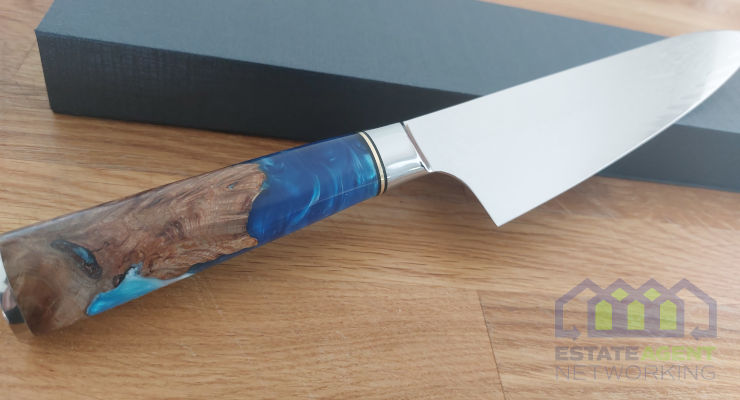The Evolution of the Chef’s Knife: From Ancient Tools to Modern Masterpieces
The chef’s knife is a tool of immense importance and is used in many kitchens across the globe and comes with as much history and tradition as the meals it cuts. As far back as the dawn of man a simple cutting edge was a necessity to survive, and as far forward as the advanced technology seen today in kitchen grade knives, the journey is a remarkable timeline. It is for this reason that the history, culture, technologies, and possible futures of one tool of the trade are explored in this blog – the chef’s knife and how it has evolved through millennia.
Historical Origins of Cutting Tools
The story of the use of the chef’s knife can be traced back to the Stone Age people. The tools of the Stone Age people included sharp-edged pebbles, stones, and rocks that were used for slicing meat, preparing food, and for as a weapon of defense. These simple tools may seem primitive compared to the tools of today, but these tools were essentials.
With the development of societies and the discovery of metallurgy these stone tools were replaced by sharper metallic blades. From Stone age to the bronze age and then to the Iron age was a revolution in terms of tool making.
Bronze led to the creation of sharp and stronger blades as compared to stone thereby making food processing easier as compared to earlier methods of food preparation. Copper was succeeded by iron, then steel, had the basis for the subsequent new types of cutting tools, while specialized kitchen knives are still in the process of development.
Cultural Influences on Knife Design
As civilizations grew and developed unique culinary traditions, the design of kitchen knives began to reflect the specific needs and preferences of different cultures. In Japan, the art of knife-making became deeply intertwined with the country’s culinary culture. Japanese knives, such as the Santoku and Nakiri, are designed with precision and delicacy in mind, ideal for preparing sushi and other traditional dishes.
These knives are often single-beveled, allowing for ultra-fine cuts, and are made using techniques similar to those used in crafting samurai swords. In contrast, Western knives, particularly the chef’s knife, evolved in Europe alongside the rise of French and German culinary traditions. The Western chef’s knife, typically double-beveled, was designed for versatility, capable of performing a wide range of tasks from chopping vegetables to slicing meat.
The influence of these cultural traditions is evident in the distinct differences between Japanese and Western knives, both in terms of function and aesthetics.
Technological Advancements in Knife Making
The evolution of knife-making technology has played a crucial role in shaping the modern chef’s knife. Early forging techniques were labor-intensive, requiring skilled artisans to hammer blades into shape by hand. Over time, these traditional methods were supplemented and eventually overtaken by more advanced techniques. The introduction of drop forging, where a metal blank is placed under a powerful drop hammer, allowed for more consistent and durable blades.
Modern advancements in materials science have also contributed to the development of superior knives. High-carbon steel, known for its sharpness and edge retention, became the material of choice for many high-end knives. Stainless steel, while slightly softer, offered the benefit of corrosion resistance, making it ideal for everyday use.
The Role of Knife Makers and Brands
The evolution of the chef’s knife is also a story of the artisans and brands that have dedicated themselves to perfecting this essential tool. Renowned knife makers, such as Wüsthof in Germany and Shun in Japan, have become synonymous with quality and craftsmanship. These brands, often steeped in centuries-old traditions, have continued to innovate while maintaining a commitment to excellence. The debate between artisan-made knives and mass-produced models is ongoing, with each offering distinct advantages.
Artisan knives, crafted by hand, often embody a level of detail and customization that appeals to professional chefs and enthusiasts alike. In contrast, mass-produced knives, while lacking in uniqueness, benefit from advanced manufacturing techniques that ensure consistency and reliability at a more accessible price point. Regardless of the production method, the impact of these knife makers on the evolution of the chef’s knife cannot be overstated.
Ergonomics and Design Evolution
As the culinary world has evolved, so too has the design of the chef’s knife, particularly in terms of ergonomics. Early knives, while effective, often lacked the comfort and control that modern users expect. Over time, knife designers began to pay closer attention to the shape and material of handles, recognizing that a well-designed handle can significantly reduce fatigue and improve cutting precision.
The introduction of synthetic materials like POM (polyoxymethylene) and thermoplastic elastomers has allowed for handles that are both durable and comfortable, providing a secure grip even when wet. The balance of a knife, which is determined by the distribution of weight between the blade and the handle, has also been a focus of design evolution. A well-balanced knife feels natural in the hand, making it easier to perform intricate cuts with minimal effort.
Modern Manufacturing Techniques
Modern technological advancement in industrial manufacturing has really boosted the production of chef’s knives to higher standards of accuracy. For instance, CNC (Computer Numerical Control) machining of stainless-steel blades ensures that each knife is made with great precision, thus conforming to set quality standards.
Together with laser sharpening, the blades feature edges which are extremely sharp and consistent with the ideal Beveling angle once the product is used right from the packing. Other important aspects are quality control where various tests are conducted on the knives to ensure that none of them gets out of the factories with blotches.
The Future of Chef’s Knives
In future the advancements and incorporations in material and technologies are expected to lead the future of chef knives. Future technology in the form of nanotechnology and graphene could lead to lighter, stronger and sharper blades than currently used. The other potentiality is the inclusion of smart technology into the kitchen utensils and equipment.
It can be a knife that has sensors on the blade that analyzes the foods being cut, or a knife blade that sharpens itself every now and then. But much these values may sound like science fiction, they are not far away, especially given the present rate of technological innovation.
Conclusion
The history of using the chef’s knife will signifies the uses of human being, cross-cultural implication, and technological advancement. Comparing the simple stone instruments utilized by the cavemen to the advanced and personalized knives that chefs use today, the timeline of a chef’s knife line embodies many significant trends in history, culture, and technology.









